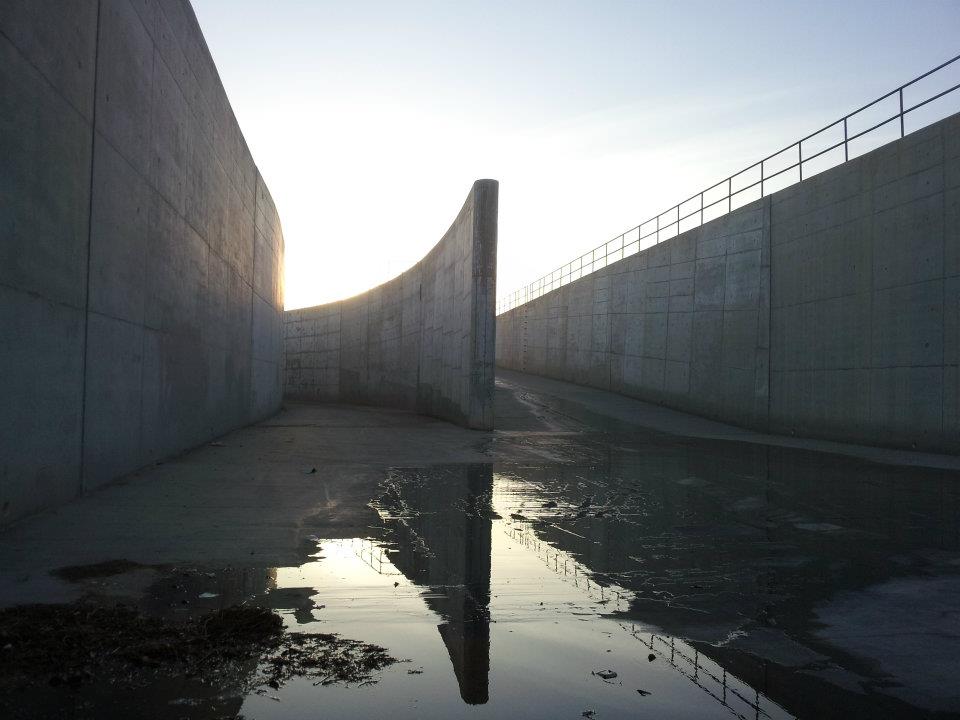The Flood Channels
Beneath Las Vegas are miles of underground tunnels leading out of the city in all directions. “Underground tunnels” probably evokes images of hazardous, claustrophobic places, full of rusting pipes, electrical wires, and steam valves. But these tunnels are not part of the sewage or electrical system. They were meant solely to control floods. In the unlikely event of heavy rain, the city, being situated in a valley, would be flooded if not for these channels directing water away from the city into vast desert basins.
A few years ago Jason discovered an entrance to the channels by the desert next to his house. From a distance, it looked insignificant—cement walls topped by wire fences, like just another municipal structure. Walking up to it, I saw that the walls maintained a section dug out of the hill. On the wall facing into the center of Vegas was a square tunnel, as wide and tall as a single lane road. Jason handed me a flashlight and we headed in.
Except for the occasional manhole cover that led into the tunnels, they were bare of any structural features. These tunnels were simply long chambers of grey concrete. Occasional painted numbers, six digits long, marked the distance.
After a few minutes of walking, I glanced over my shoulder. A wall of pitch black met my eyes. Switching off the flashlight left us in total darkness. We were somewhere in the middle of this mile long tunnel.
The air was dry and cool. A slight draft constantly swept through. Combined with the utter darkness, the lack of sound became equally unsettling. Unused to total silence, my ears became jittery, expecting to hear something at each successive moment, but hearing nothing, like that feeling of unbearable suspense one gets immersed a well-crafted horror film. This hyper-expectant state made me hyper-sensitive. Occasionally, a car would run over a manhole cover, causing a sudden, jarring clunk to echo through the tunnel. My body jolted at each random sonic impulse of iron against iron, sustained and amplified down the concrete chamber.
After what felt like an hour of walking, we emerged from the other side into the sunlight. A wave of relieving sensory phenomena washed in. My eyes and ears once again bathed in the sights and sounds of the world. This section of the channel was exposed to the sky—clouds passed slowly overhead, airplanes droned, the highway roared softly in the distance. Caught in the wind, plastic bags whirled about with choreographic elegance. Empty, half crushed beer cans clanked along.
The floor was littered with trash: bottles, newspapers, plastic bags, ragged clothing, anything that the previous rain had carried with it. More and more frequently we saw signs of previous inhabitants. Dark smoke stains rising on the walls. Dirty mattresses. Bicycles hung up to avoid being washed away. I wondered if anyone lived in such an isolated place, and if we would encounter them. Probably not, I thought. This place felt like a ghost town.
The channel widened. The walls rose higher. I saw graffiti, most of it just a mess of neon lines layered on top each other. “HOLE” in large, ugly block letters, an arrow beside it pointing to a hole in the wall. Numerous hastily drawn penises drawn in two circles and a stretched out “U”. Beneath a red scrawl lay the image of a face painted in purple. Angular lines outlined its eyes, eyebrows, nose, and mouth in a way that implied the rest. The resulting gaze was so striking that we stopped to stare back it.
More and more frequently lateral tunnel openings appeared on either side. Other channels converged upon this one, Jason said. We were walking along one of the main channels that led to a wash. I looked down one these side tunnels, only ten feet wide and a few feet tall. Deep inside the tunnel obscured in the dark was a mattress, pots, a blue tarp, plastic water bottles, and other things I couldn’t identify. Part of me wondered if that lump on the mattress was a person.
Sometime later we encountered a man camped out in the channels. Hidden in the darkness, he spotted us first and whistled to get our attention. Instinctively I turned off the flashlight and stopped, my heart pounding, legs tensed up and ready to sprint back. Jason, a seasoned channel explorer, called out to the man, asking permission to pass. “Sure, go ahead,” the man said. I cautiously follow Jason forward as he approached him. Jason offered him food and water, but he declined. Besides being unshaven the middle aged man appeared in good condition. His clothes weren’t ragged. He had a mattress, pillow, and a cart full of food and water. I spotted a large knife lying on his bed within arms reach. Later, Jason explained that people down here need a way to defend themselves: “Being alone in this kind of place, you need to be prepared for anything.”
“We’re just passing through, I’m showing my friend around.”
The man nodded his head. “Keep reading the bible. The Revelation is coming.”
He went on to warn us about the apocalyptic dangers ahead. Instead of preaching to us the typical fire-and-brimstone voice of urgency, he spoke to us casually, nodding his head for emphasis. We asked him once again if he wanted food or water. He shook his head, insisting he was fine. As we walked on, I wondered if he really was fine. I wondered if he denied our help out of dignity, under some illusion that he was okay. I resisted the urge to glance back. Planes droned and the highway hummed in the background. All of it seemed far away in the distance.
Photo by Jason Kim.

